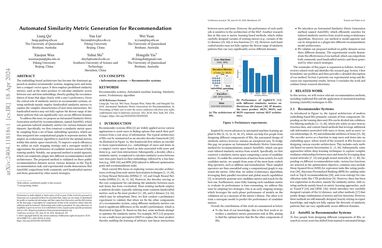Automated Similarity Metric Generation for Recommendation
The embedding-based architecture has become the dominant approach in modern recommender systems, mapping users and items into a compact vector space. It then employs predefined similarity metrics, such as the inner product, to calculate similarity scores between user and item embeddings, thereby guiding the recommendation of items that align closely with a user's preferences. Given the critical role of similarity metrics in recommender systems, existing methods mainly employ handcrafted similarity metrics to capture the complex characteristics of user-item interactions. Yet, handcrafted metrics may not fully capture the diverse range of similarity patterns that can significantly vary across different domains. To address this issue, we propose an Automated Similarity Metric Generation method for recommendations, named AutoSMG, which can generate tailored similarity metrics for various domains and datasets. Specifically, we first construct a similarity metric space by sampling from a set of basic embedding operators, which are then integrated into computational graphs to represent metrics. We employ an evolutionary algorithm to search for the optimal metrics within this metric space iteratively. To improve search efficiency, we utilize an early stopping strategy and a surrogate model to approximate the performance of candidate metrics instead of fully training models. Notably, our proposed method is model-agnostic, which can seamlessly plugin into different recommendation model architectures. The proposed method is validated on three public recommendation datasets across various domains in the Top-K recommendation task, and experimental results demonstrate that AutoSMG outperforms both commonly used handcrafted metrics and those generated by other search strategies.
PDF Abstract

 MovieLens
MovieLens